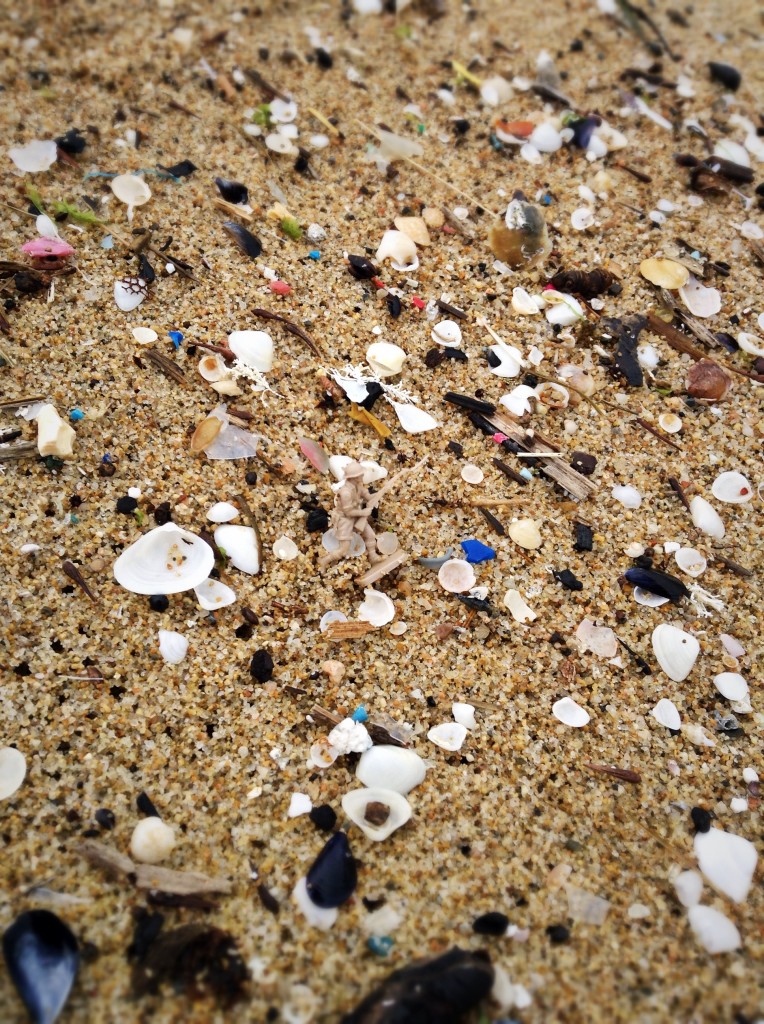
Seabird feathers, brick, driftwood, granite beach stones, mussel shells (prob. Mytilus galloprovincialis), balloon, European Green Crab (Carcinus maenas), bottle cap, sunflower seeds, pottery, sea glass, sugar packet, plastic army man, Euro penny, rose petal, limpet with Coralline and seaweed, clam shell, Toad or Lyre crab (prob. Hyas species)
I’m sorry for all this jumping back and forth in time, but real life keeps throwing fresh, interesting experiences at me before I’ve finished sharing the older ones with you. As far as dilemmas go, it’s a pleasant one, but it offends my logical mind. Today’s post leaps back to Barcelona on May 20 – I’ve just finished the final revisions on the still life photo from that day’s beachcombing. Looking at the map in my last post on Barcelona, Platja San Sebastià is just north of Platja Barceloneta, and I’m not really sure where one stops and the other begins.
It was cool, humid, overcast, and very windy. I was on the beach by about 10am, which is the crack of dawn by Barcelona standards, so there were very few people out. There was some interesting activity, though, which answered several questions from the last Barcelona post:
 This crew is laying out boardwalks across the sand from the esplanade to the high tide line. Other crews were busy grooming the beach, mostly burying the trash but also removing it. Do you remember the questions I posed last time: 1) Why was the sea glass so small? 2) Why was there no “raw” sea glass (i.e. broken glass.) 3) That’s a very odd mixture of stones. What is the geology here? 4) That big white thing at the top is a cuttlebone, the internal structure of a squid. Why have I never found one of those on the shore in Maine?
This crew is laying out boardwalks across the sand from the esplanade to the high tide line. Other crews were busy grooming the beach, mostly burying the trash but also removing it. Do you remember the questions I posed last time: 1) Why was the sea glass so small? 2) Why was there no “raw” sea glass (i.e. broken glass.) 3) That’s a very odd mixture of stones. What is the geology here? 4) That big white thing at the top is a cuttlebone, the internal structure of a squid. Why have I never found one of those on the shore in Maine?
I think the beach grooming explains #2.
I think that #1 and #3 have a similar cause – these are artificial beaches. As nearly as I can tell, the shoreline of Barcelona was originally marshy, but by the end of the 19th century the marshes had been drained to provide farmland and eradicate malaria. The current beaches were apparently built for the 1992 Olympic Games, although I can find nothing about the nature of the shoreline in the years between. The sand is replenished regularly, which explains why all the sea glass is so small – it must get polished during the excavation and transportation of the sand, and also why there is such a peculiar assortment of beach stones – some must be washed in from offshore, while others are imported with the sand. If, no when, I get back to Barcelona, I will make a point of visiting the Museu Blau, a new science museum which I understand houses the collection of the former Museu de Geologia. Perhaps I can find more information about the changes in the shoreline there.
And I don’t have an answer to #4, unless perhaps the cuttlebones I found on Platja Barceloneta were discarded by fishermen just offshore, and there are fewer people fishing for squid here in Maine, or they don’t clean their squid til they get home… But that’s a wild guess.
P.S. Did you see the miniature soldier in the last photo? He shows up in the still life, too.


